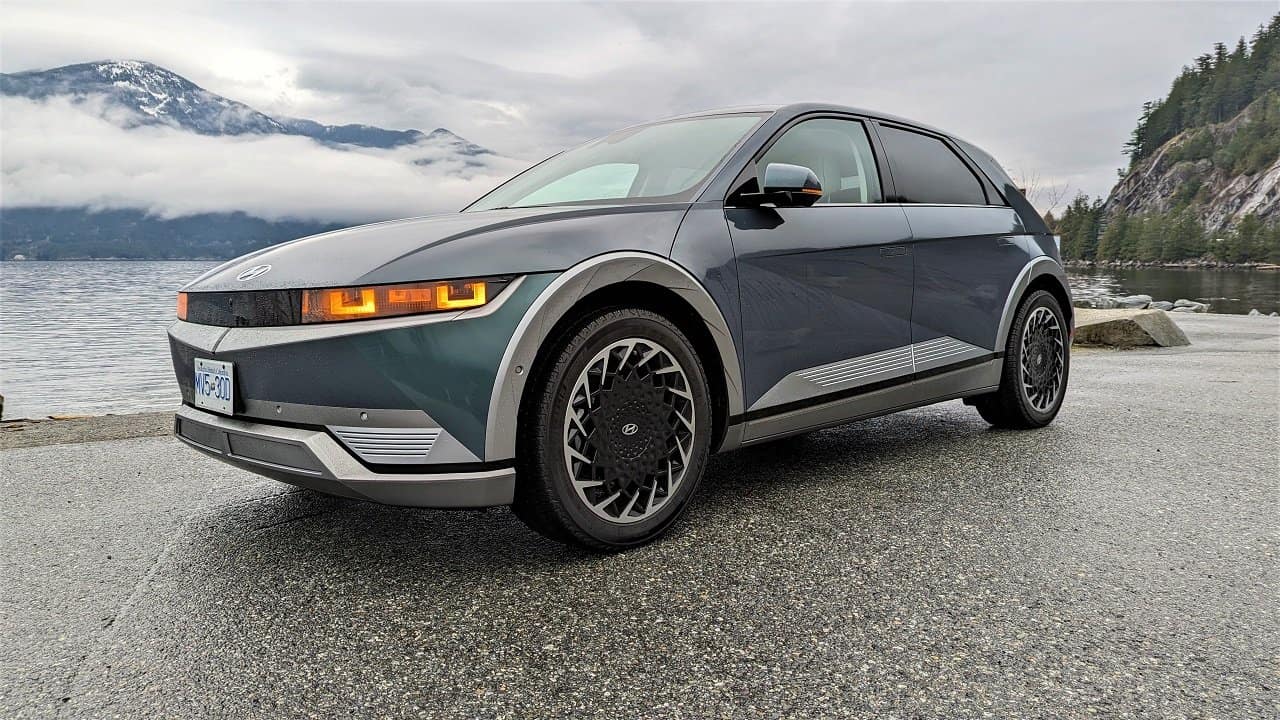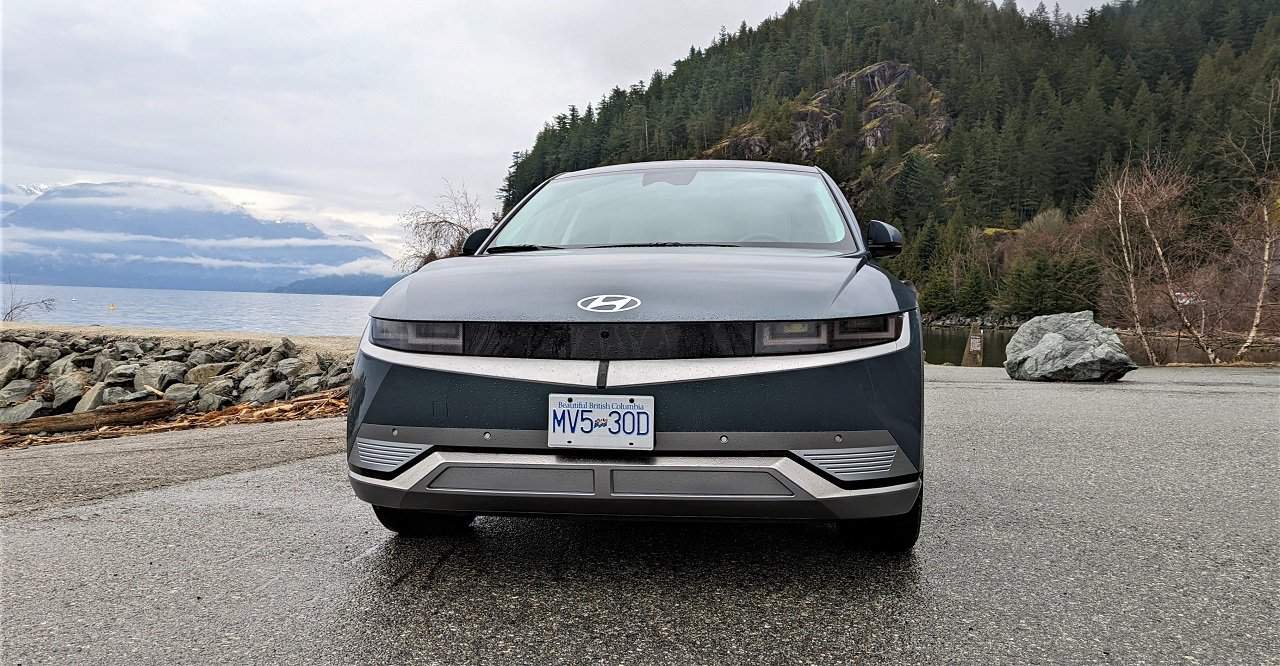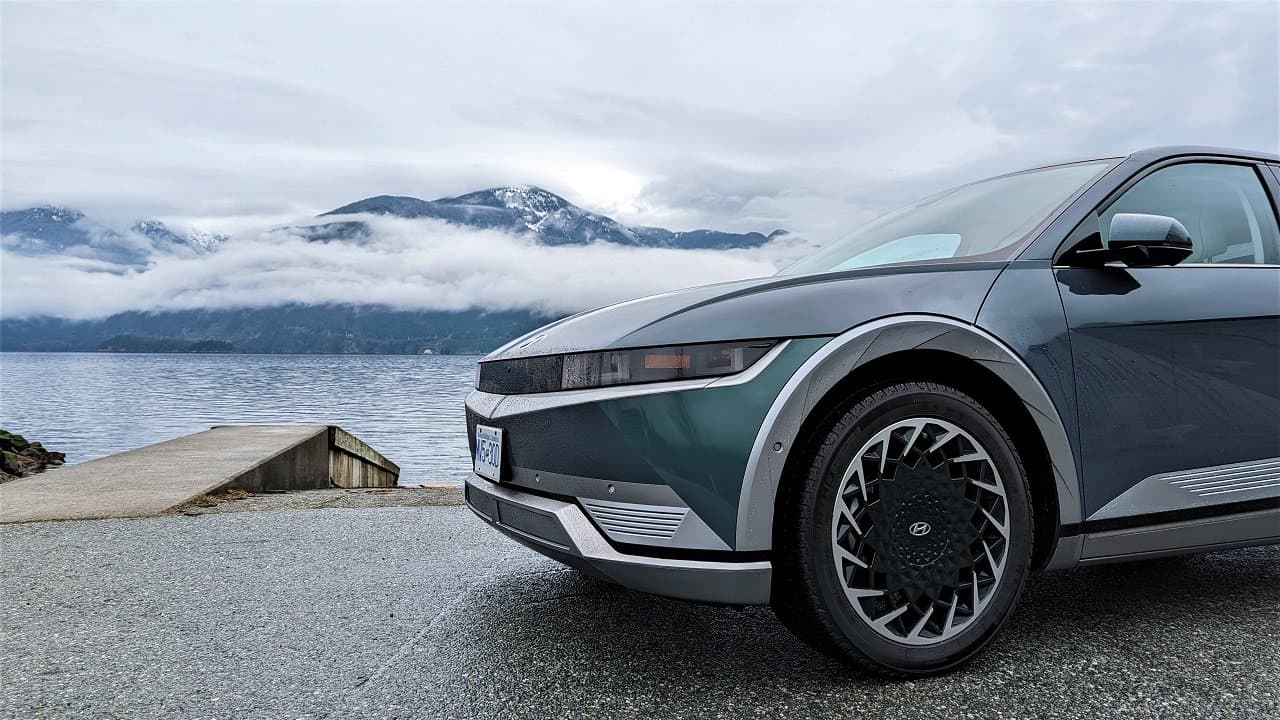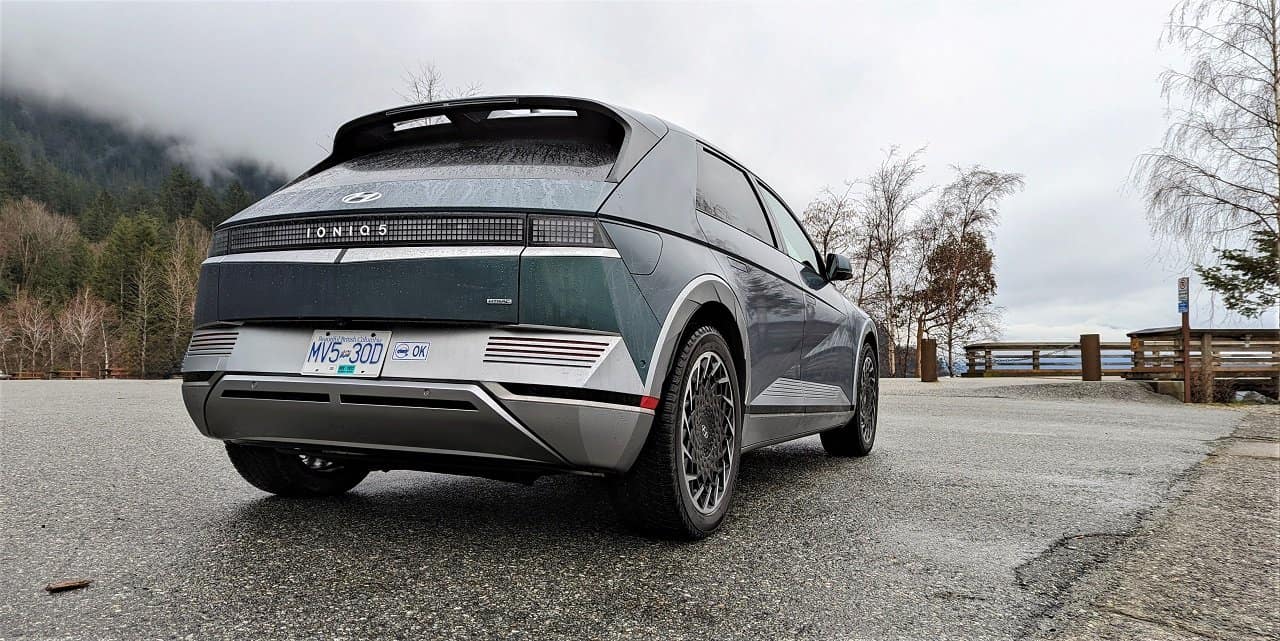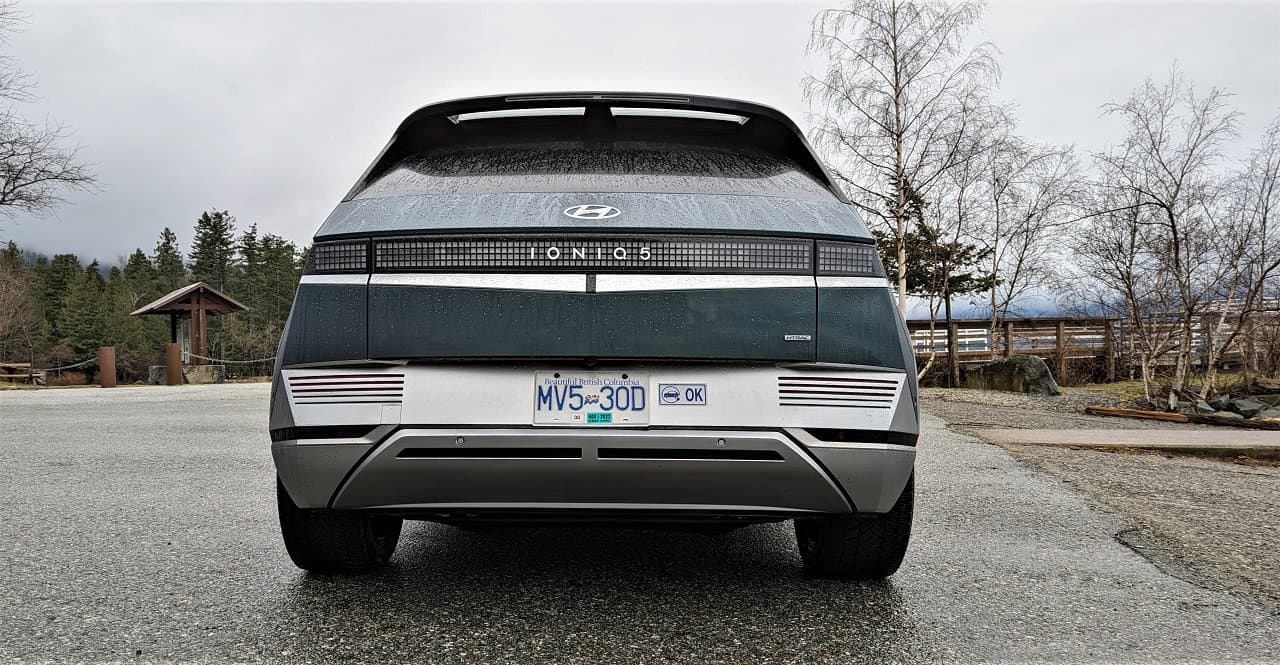The Hyundai Ioniq 5 was first revealed to the world on February 23, 2021, and I have eagerly anticipated its arrival here in North America. It has been on sale in Korea and other markets since mid-2021; however, the first Ioniq 5’s started arriving in North America in December 2021.
Hyundai has been producing a car called the Hyundai Ioniq, but that’s a totally different car. Hyundai is creating a sub-brand called IONIQ, which will feature electric cars only. The first of which is the Ioniq 5, later to be followed by the Ioniq 6 and other models. The Ioniq 5 is the first vehicle to use Hyundai’s new Electric Global Modular Platform (E-GMP). This platform is currently shared with the Kia EV6 and the Genesis GV60, both all-electric vehicles. We’ll be reviewing those in the near future.
I absolutely loved the styling on the Ioniq 5 from the first time I saw it. I know this is subjective, but everyone I’ve talked to has liked the bold styling direction Hyundai went with rather than giving us another aerodynamic blob of an electric car. I liked the styling so much that I put down a deposit to purchase one of these vehicles before even setting foot in it or even seeing it in person.
After spending a week with the 2022 Ioniq 5, did I make the right choice by putting down a deposit? Is the Hyundai Ioniq 5 a good car? Keep reading and I’ll tell you my thoughts on the all-electric Ioniq 5.
What Will The Ioniq 5 Cost in Canada?
In Canada, the 2022 Ioniq 5 comes in two main trims. The Essential and the Preferred. In the USA, there are three trims, called the SE, SEL, and Limited.
The Ioniq 5 Essential has a price of $44,999, and the Preferred starts at $46,999. But that’s not all. The Preferred can be bought with a bigger battery; it becomes the Preferred Long Range with a price of $51,999. Adding AWD, it becomes the Preferred AWD Long Range, and the price jumps to $54,999. If you want even more equipment, add the “Ultimate Package” to the aforementioned, and the price jumps to $59,999.
The standard paint on the Ioniq 5 is the Atlas White; any other paint is an additional $200, and $1,000 for the Shooting Star Matte. Delivery & Destination adds $1,850 to the price.
You may ask, why did Hyundai only have two trims in Canada and three trims in the USA? The answer lies in how our EV rebate/incentives work; Hyundai has brilliantly priced the Ioniq 5, where even the most expensive Ioniq 5 qualifies for the largest rebate/incentive. How does the Canadian EV incentive work? I’ll explain below.
In Canada, there are two incentives for electric vehicles. There’s a federal incentive of $5,000 and a provincial incentive ranging from $0 to $8,000. Some provinces offer no incentives, British Columbia offers $3,000, and Quebec offers $8,000 ($7,000 as of April 1, 2022). To qualify for these incentives, the vehicle’s base price must be less than $45,000, and the highest trim must be less than $55,000. Adding different optional paint, wheels, and “packages”, which would increase the price, does not disqualify the vehicle from receiving the incentives.
That’s why we only get two trims on the Ioniq 5 in Canada, while in the US, the rules are different and they get three trims. Does the Hyundai Ioniq 5 Preferred Ultimate qualify for Canadian EV incentives? Yes, because it meets both criteria of the base price of sub-$45,000 and the top trim not costing more than $55,000. While adding the Ultimate Package does increase the price to $59,999, it’s only a “package” and not a trim, so you’d get the full Federal and Provincial (if available) EV incentive.
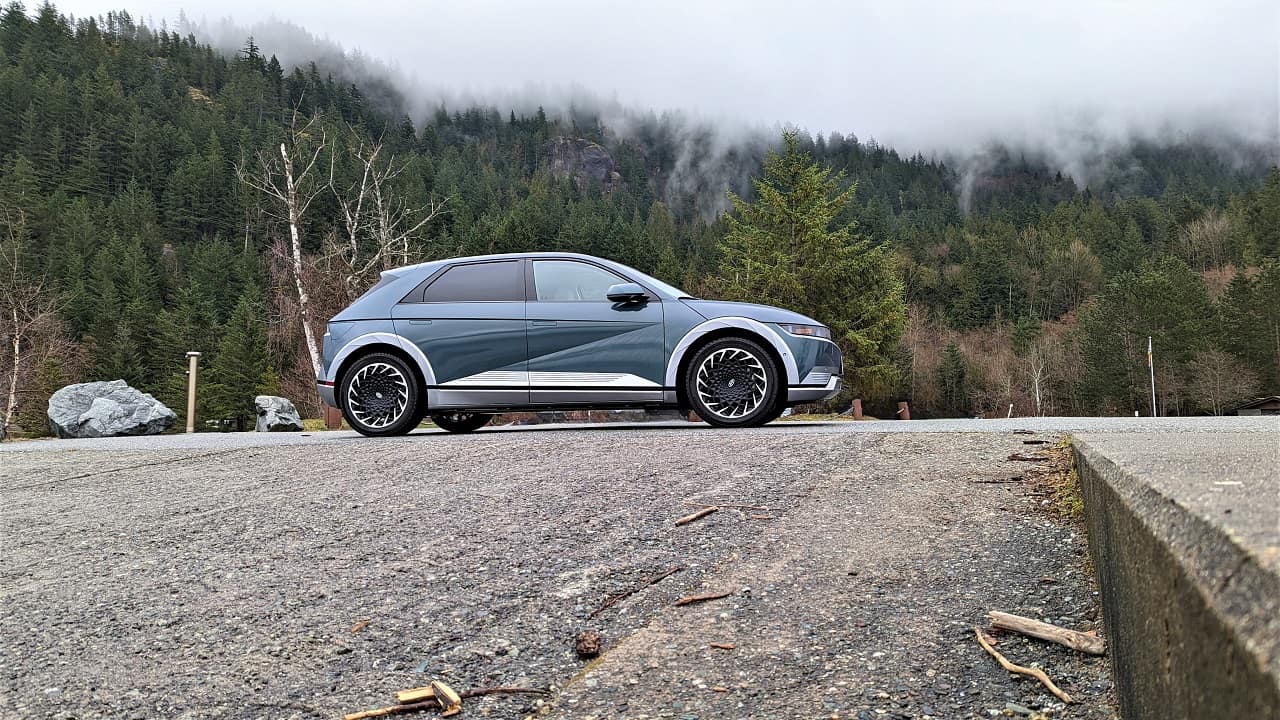
What Are The Battery Sizes For the Ioniq 5 in Canada & the USA?
In Canada and the United States, the Hyundai Ioniq 5 is offered with two battery sizes. The Ioniq Essential is offered with the 58-kWh lithium-ion polymer battery pack only; this battery pack has 24 modules, which consist of 288 cells. The 58-kWh battery pack is paired with a 125-kW motor, which translates to 168 horsepower with 258 pound-feet of torque. This combination is rated at 354 kilometers (220 miles) and a 0 – 100 km/h time of 8.5 seconds.
The Preferred SR (Standard Range) also comes with the same battery pack; however, you can add the LR (Long Range) battery pack, which is a 77.4-kWh unit (32 modules with 384 cells). This battery pack gets the more powerful 168 kW motor, which is 225 horsepower and 258 pound-feet of torque. This combination is rated at 488 kilometers (303 miles) and a 0 – 100 km/h time of 7.3 seconds.
The Preferred Long Range AWD has the same battery pack but adds an additional motor at the front axle. The rear motor is 165 kW and the front motor is 74 kW, for a combined output of 320 horsepower and 446 pound-feet of torque. This combination is rated at 414 kilometers (257 miles) and a 0 – 100 km/h sprint of 5.1 seconds.
Below is a summary of the range and power figures for the different configurations of the Ioniq 5.
- SR RWD – 354 km
- LR RWD – 488 km
- LR AWD – 414 km
These are pretty impressive driving ranges; however, these ranges are dependent on your driving style, the number of passengers/cargo, and weather conditions. One of the biggest enemies of range is cold weather. In cold weather, especially Canadian winters with sub-0 temperatures for months, you can expect to lose 20 – 30% range just because it’s so cold. Add in the fact that when it’s this cold outside, you’ll need to run on the cabin heater, which is also detrimental to the driving range. This can be somewhat negated by pre-heating the cabin while the Ioniq 5 is plugged in; this way, the heater draws power from the outlet while it’s plugged in, saving you the range for driving. Hyundai also included a heat pump on all but the base trim, which theoretically helps heat the cabin/batteries.
What is the Ioniq 5’s real-world range? Again, this will depend on where you live. Our review took place in Vancouver, BC, which has mild winter temperatures. Our review occurred in early March, with temperatures ranging from 0 – 10 degrees Celsius, which is not too cold. Most of the 0’s happened overnight; during the day, the temperatures were in the 5 – 10-degree range. On a fully charged battery, I saw the estimated driving range from 431 kilometers, on the coldest days of the week, to 444 kilometers on the warmest days. I also have a very gentle throttle foot, which helps with the range in electric cars and fuel economy in ICE cars. These projected range numbers also didn’t include the heater, which reduced my expected driving range number by around 8%.
After battery size, an electric car’s other most important metric is its charging speed. The Hyundai Ioniq 5 has an impressive 800-volt system (it can charge at 400 or 800 volts without changing between the two manually). I believe the Porsche Taycan is the only other vehicle with 800-volt architecture. What does the 800-volt system do? It lets you charge your Ioniq 5 fast, like really fast. The Ioniq 5 can be charged at up to 350 kilowatts DC fast charging stations. According to Hyundai, the Ioniq 5 can charge from 10% to 80% in 18 minutes on a 250 or greater kW DC fast charger. It can gain up to 108 kilometers of range in 5 minutes on these super-fast chargers. On a 150 kW DC fast charger, it takes about 25 minutes to charge from 10% to 80% or 68 kilometers of range in 5 minutes. On a level 2 (10.9 kW 240-volt home charger), it should take 6 hours and 43 minutes to charge from 10% to 100%.
As impressive as the above charging times are, they’re “claimed” numbers, and your results will vary. These numbers are based on ideal conditions, which include nice warm weather, warmed-up batteries, and the DC fast charger actually working properly. Since I have a deposit down on the Ioniq 5, I have been reading up on forums and watching many videos about it. So far, I have yet to see anyone achieve the 18-minute charge times (10% to 80%).
The Current Issue with all Electric Vehicles
The big problem I found was that there are no DC “super-fast” chargers close to where I live. The only ones I’ve found were the 50 kW chargers. I used the BC Hydro DC fast charger close to my house, but the experience wasn’t great. The app showed the two chargers were available, but by the time I got there, someone had taken the spots, so I had to wait 40 minutes for them to get done, and then I could only charge for 40 minutes due to their time limits. I only charged for a few minutes because I wanted to experience living with an electric car. The Ioniq 5 could be charged at 50 kW after a few minutes of being plugged in. If you live in an apartment, you’ll need to drive around a lot just looking for a space to charge up your EV.
In Vancouver, there are plenty of “slow chargers,” and many are free to use. That is if you can get a spot. These are great for topping up your EV when you’re shopping or out for dinner. I was able to charge at a free 6.2 kW charger, with a limit of two hours. The Ioniq 5 gained 60 kilometers of range in two hours, which works out great if you’re at a mall, shopping, walking around the mall, and grabbing a bite to eat. In the future, I can see malls and big box retailers/grocery stores having 10’s (100’s?) of these installed in their parking lots. Top up your batteries while you shop.
Of course, the best way to charge an electric vehicle is at home. Even using a standard 120-volt outlet is more than enough if you have an average commute, which is a number I could not find. But let’s assume 50 kilometers per day. I gained just over 5 kilometers of range per hour when the Ioniq 5 was plugged into a 120-volt outlet. 14 hours of idle time before/after work should give 70 kilometers of range. If you have a plug at work, that increases your range even further.
Most people with electric cars and living arrangements where they can install level 2 chargers do opt for that option. Using a 220-volt outlet gives you more than enough range for daily driving, even if driving more than 200 kilometers a day.
More and more automakers are offering fully electric cars, so the charging infrastructure will only improve. Tesla had it right from the beginning; they have a huge advantage with their supercharger network. I’m optimistic there will be plenty of places to charge your EV in the future.
Driving the 2022 Hyundai Ioniq 5
Our review car was the 2022 Ioniq 5 Preferred AWD with the Ultimate Package; it came with the biggest battery and dual motors, the most powerful combination currently available. I say currently because there’s a planned Ioniq 5 N in the works with over 500 horsepower. However, the 320 horsepower and 446 pound-feet of torque are more than enough power for this car.
The beauty of electric cars is their instant torque, which the Ioniq 5 has plenty of. You don’t have to wait for the power to transfer via a slow transmission to the wheels; the power delivery is almost instant on the Ioniq 5 (and most electric vehicles). The Ioniq 5 has four driving modes: Eco, Comfort, Sport, and Snow. These modes are self-explanatory, and most new cars offer them, but these same modes in an electric car change the way the car drives much more than in an ICE car.
I mostly drove in the Eco mode, which maximizes efficiency and uses the rear motor. The Ioniq 5 is plenty fast in this mode, and putting your foot down hard will bring the front motor into the equation and you’ll pass ICE cars rather quickly if need be. The comfort mode increases throttle response, and you get a little more juice from the batteries. The Sport mode is the sportiest, with both motors at the ready, giving you all the power you desire. In this mode, the Ioniq 5 is downright fast and it will have your passengers in a state of shock. It’s pretty surprising (and fun) how quickly a large vehicle like the Ioniq 5 can accelerate.
You’ll consume the most electricity in the Sport mode, but sometimes it’s worth having a little fun. The Ioniq 5 doesn’t come with any fancy adjustable suspension and other adjustable goodies, so it’s not that great in the corners, I mean, it feels planted with all the weight down in the floor, but there is body roll when you’re cornering hard. The Ioniq 5 isn’t a sports car, although it accelerates like one, so it’s expected to have a bit of body roll, making the ride more comfortable than a stiff suspension. One thing I did notice, you can accelerate hard, but the brakes are what you’d expect in a family car. So, when you accelerate hard, ensure you don’t need to brake hard because the Ioniq 5 doesn’t come with sports car-like brakes.
The Ioniq 5 comes with adjustable regenerative braking. The steering wheel comes with two paddles; the left increases the regen level, and the right decreases it. There are four levels of regen: L1, L2, L3, and i-Pedal. The i-Pedal is one-pedal driving and will bring the Ioniq 5 to a complete stop. I didn’t use the i-Pedal because you need to fully understand how much distance it takes the Ioniq 5 to come to a complete stop, and without driving it for a while, it’s hard to judge the stopping distance properly. There’s an Auto regen setting as well; by holding the right paddle for a second or two, the regeneration is done automatically based on the road conditions, and the camera system adjusts regeneration based on the vehicle in front of you. This setting does not bring the vehicle to a full stop and you’ll need to be ready to apply the brakes manually.
The suspension and steering feel like a family CUV, which is fine. The Ioniq 5 is about comfort and style. Additionally, the Ioniq 5 features a 3,000-millimeter (118 inches) long wheelbase, longer than the Hyundai Palisade’s, which smooths out the ride quite a bit. The Ioniq 5 is one of the smoothest riding vehicles I’ve driven in a long time; even with the bigger 20” wheels on our top trim, the suspension soaked up the bumps quite nicely.
According to Hyundai, the Ioniq 5 should consume 21.3 kWh/100 km in combined driving. In gasoline terms, that translates to 2.1 Le/100 km in the city and 2.7 Le/100 km on the highway. Le stands for Liters Equivalent, which is described below:
To help compare vehicles that use electricity, a conversion factor is used by NRCan to convert electrical energy consumption values, expressed in kilowatt hours per 100 kilometers (kWh/100 km), into gasoline liters equivalent per 100 kilometers (Le/100 km). One liter of gasoline contains the energy equivalent to 8.9 kWh of electricity.
I took a 200-kilometer trip, which included a mix of highway and city driving, both uphill and downhill; with the heater on, the onboard computer showed 20.9 kWh/100 kilometers. I drove at a normal pace, mostly in the Eco mode.
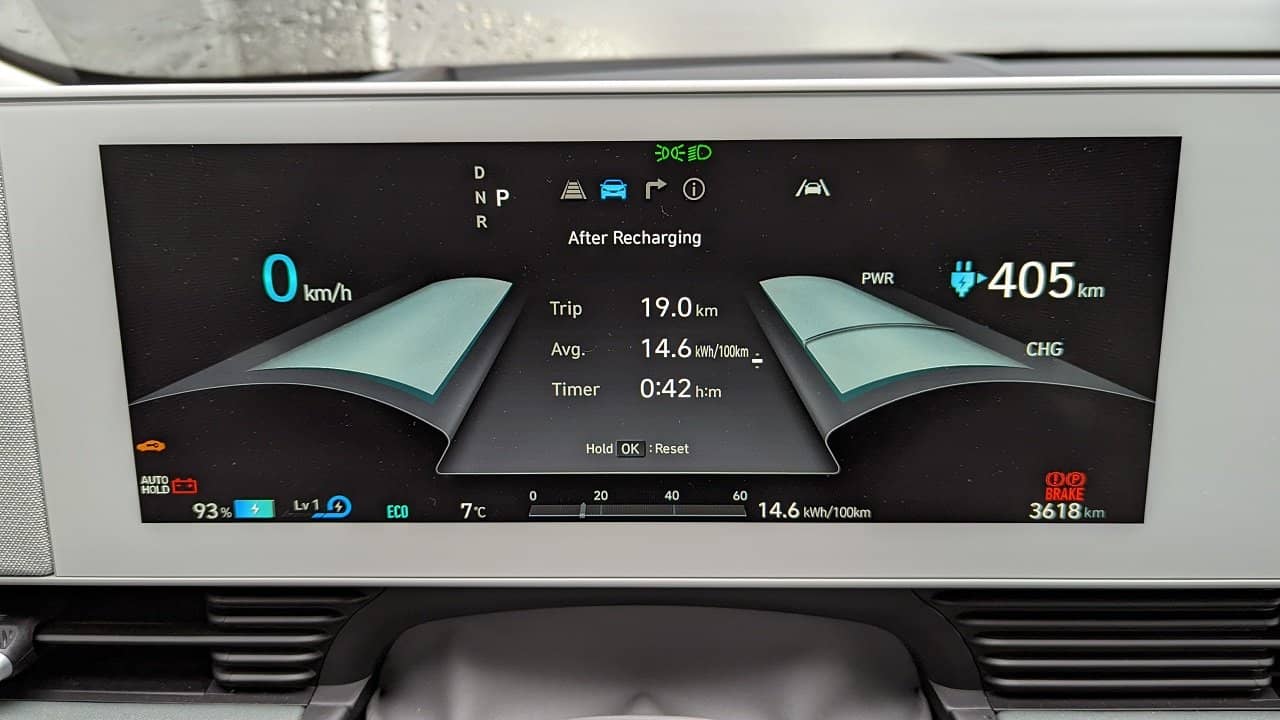
On a separate test, I drove in the city with efficiency in mind; I drove smoothly and slowly but without hindering traffic (the heater was turned off, but the heated seat and steering wheel were on), and I was able to get the best consumption number of 14.6 kWh/100 km (see image above for proof). This number isn’t too hard to get in Vancouver’s congested streets.
But let’s stick with the 20.9 kWh/100 km number to figure out how much we would spend at the fuel pump if this was a gasoline vehicle. A car like this would probably consume 11 L/100 km (I’m being conservative) on the trip I took. With gas prices at the highest levels ever in Vancouver that week, priced at $2.119/liter for regular 87 octane, it would cost $23.31 for 100 kilometers of driving. The electricity cost is much lower. Our current electricity price is around $0.13/kWh; taking a conservative 20% loss of electricity during charging, it would take 26.125 kWh to drive 100 kilometers for $3.40 for 100 kilometers. If you convert that cost into gasoline, that equates to 1.60 L/100 km.
Hyundai Ioniq 5 Styling
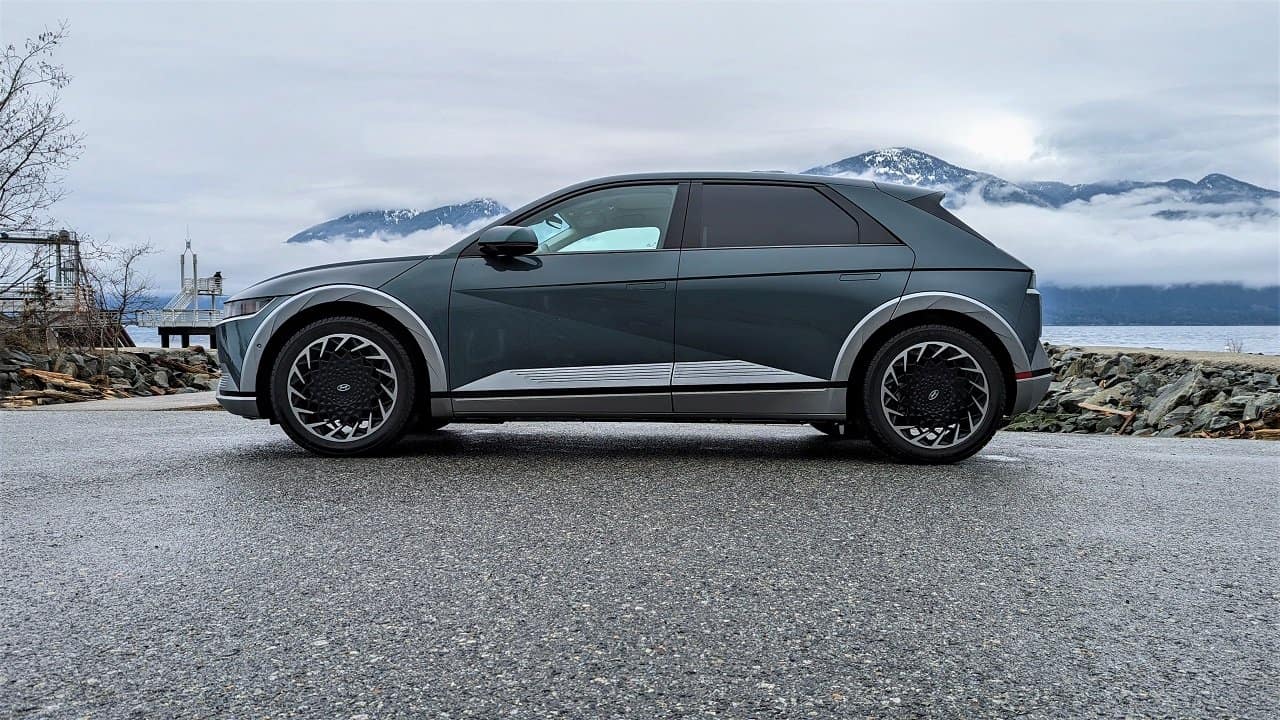
This is a subjective matter and everyone’s taste in styling is different. Personally, I like the look of the Ioniq 5 a lot. I call it “the future, as seen from the past.” The design looks like a concept car from the 80s, what they would’ve imagined a futuristic car would look like. 80’s design inspirations are apparent everywhere, especially with the “8-bit” styling cues in the headlights, taillights, and the pixels present throughout the cabin. Hyundai even removed the H logo from the steering wheel and replaced it with four square dots (or pixels). The 4 dots are Morse code for the letter H, which is Hyundai’s logo. Pretty clever use of the pixel theme.
When Hyundai initially released images of the Ioniq 5, everyone thought it was a hatchback. I thought maybe it was a retro-looking hatchback like the Honda E or a VW Golf-sized hatchback. The shape and the wheels stretched to the extreme corners gave it a hatchback look.
In person, it’s a much bigger vehicle. It’s not quite an SUV and not quite a hatchback. It’s more like a big hatchback or a CUV pretending to be a hatchback. Whatever it is, it looks good to me. Hyundai has sacrificed some range by giving it more traditional styling rather than making it look like an aerodynamic piece of excrement.
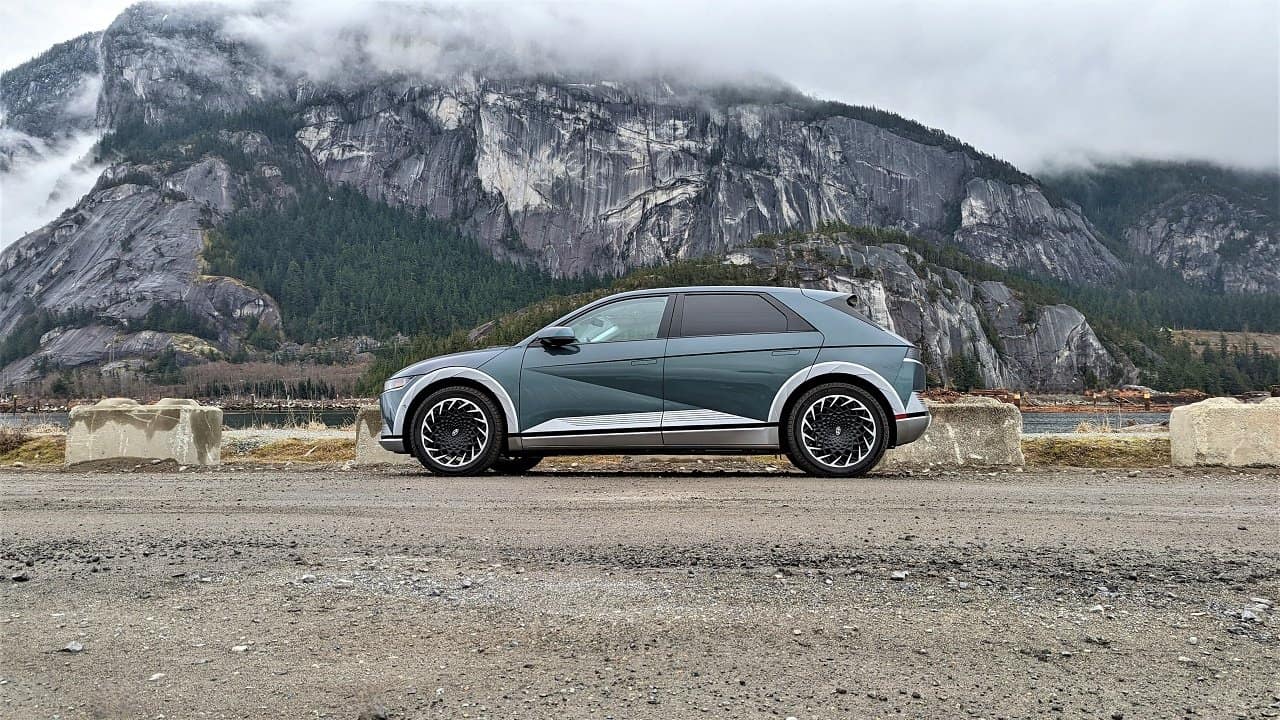
I commend Hyundai for going bold in the design language; most EVs are not very good-looking, in my opinion. The Ioniq has a memorable design that doesn’t blend into the crowd. At the front are quad-pixel headlights and sharp lines in the bumper. The body features sharp lines starting at the front door and going to the back, making a V-shape in the front door. Hyundai has been using these lines in Elantra, Tucson, and Santa Cruz, but I think this is the best execution. The Ioniq 5 features flush door handles that pop open as you get close to the car with the key fob in your pocket; this feature can be turned off. To lock/unlock the doors, either use the remote or press the little square indentation on the door handles.
The wheel wells come with silver fan-blade fender flares; the silver color is replaced with matte black plastic on all trims other than the top trim. Personally, I prefer the painted ones found on the top trim; I’m not too big of a fan of black plastics on cars in general. At the rear are more sharp lines and pixel taillights.


The Ioniq 5 features a roof-mounted spoiler with openings for air to flow down the hatch to clear the rear window of dust and rainwater. In theory, this is a great system because the Ioniq 5 does not come with a rear wiper. However, it’s a different story in real life (especially in Vancouver’s wet climate). I think not putting a rear wiper is a huge oversight by Hyundai because the “air blade” does not work, and the rear window gets dirty quickly because the rear wheels are so far back and kicking dust and water up the back. Looking out the rear glass is impossible. I rely heavily on my rearview mirror and could not see anything out the back when it was raining, even going at highway speeds, the rear spoiler’s open slots didn’t make the slightest difference. I really wish they had put in a wiper; hatchbacks are notorious for dirty rear glass and always come with rear wipers. Above is a picture my passenger took while driving at highway speeds with drizzling rain and another from the outside.
Hyundai Ioniq 5 Interior & Tech/Safety/Convenience Features
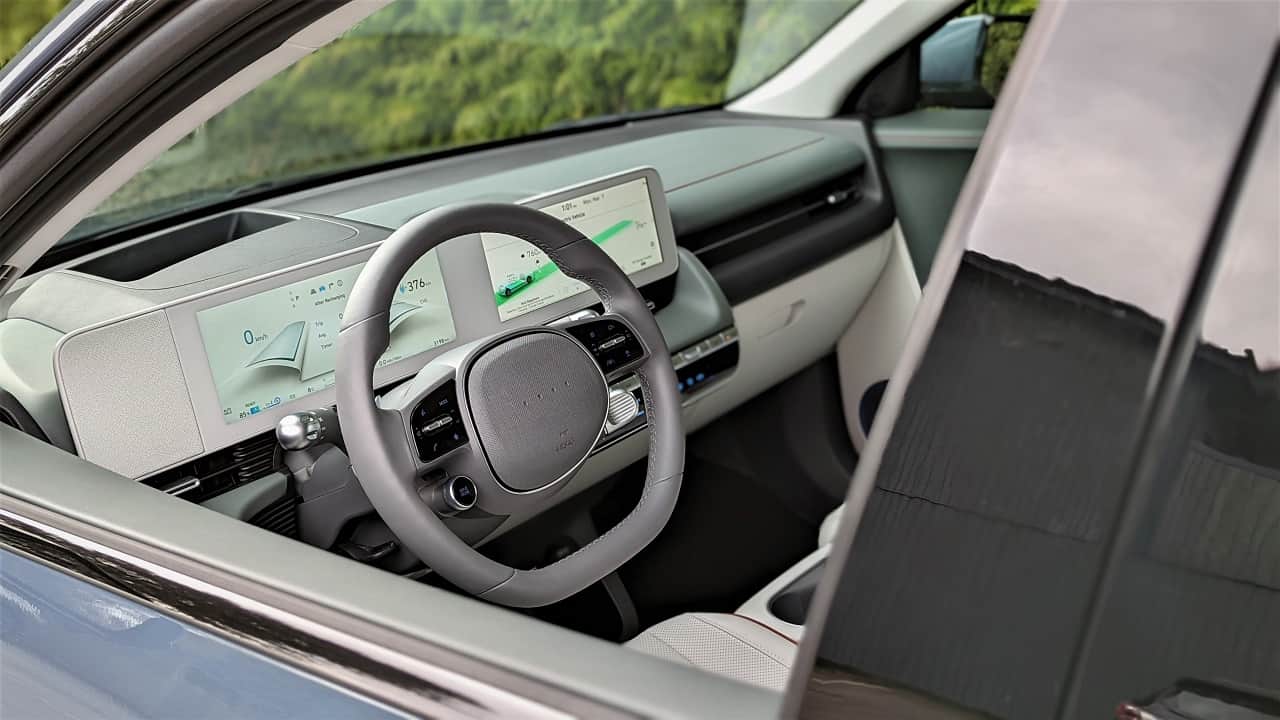
As impressive as the performance, range, charging speeds, and design have been, you’d think Hyundai would let us down on the interior. That’s not the case, especially on the top-of-the-line trim.
Thanks to the long wheelbase, the interior space is massive. The Ioniq 5 has the most second-row legroom in any vehicle I’ve ever reviewed; it might be even more than the S-Class long wheelbase. The front seats can house easily people over 6’ 5”; I tried with a few tall friends with the front seats set all the way back; they could fully stretch their legs and loved the room offered by the Ioniq 5. The second-row seats also have loads of leg and headroom. The second-row seats can be moved back and forth and have the ability to recline. With the seats all the way back and fully reclined, combined with the smooth ride, the experience is first class. Sitting in the back seat with the front seats comfortably set for my 5’ 8” frame, I found about 5-6” of spare room between my knees and the front seat. The floor is flat in the back (and in the front), making it more useful, and the middle seat is actually usable.
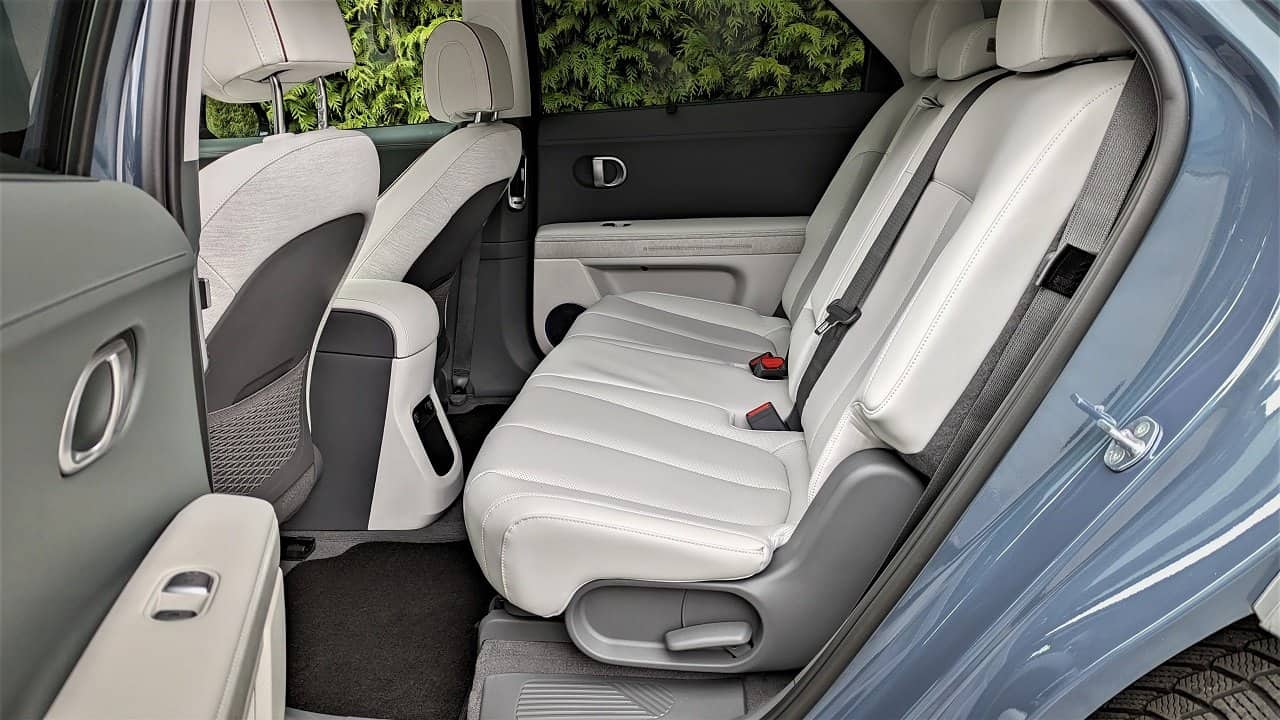
All trims of the Ioniq 5 come with dual 12.3” screens, one for the digital gauge cluster and the other for the infotainment system. With a small magnetic area to the left of the gauge cluster. The infotainment screen is the standard screen found on other Hyundai products, with additional EV-specific submenus. Most menu items are found on the touchscreen. However, there are a few physical shortcut buttons for the most used items like maps, media, and the camera system. The Ioniq 5 has a physical knob for volume control and a tuning scroller. Below these buttons is a touchscreen for the climate section. It’s fairly easy to use. However, to get to the heated/cooled seats and the heated steering wheel, you have to press the “warmer” button, which then brings up the options for the heated seats/steering wheel on the main infotainment screen. I would’ve preferred physical buttons for these functions.
The digital gauge cluster has a clean layout and is easy to read. It displays various outputs like speed, power usage, and a trip computer. This screen also has the Blind View Monitor (BVM), which displays a video feed from the left and right blind spots when the signal is turned on. Our Ultimate Package Ioniq 5 comes with a Head-Up Display with Augmented Reality navigation directions. The HUD displays the speed, speed limit, blind spot warning, and directions when the navigation system is in use.
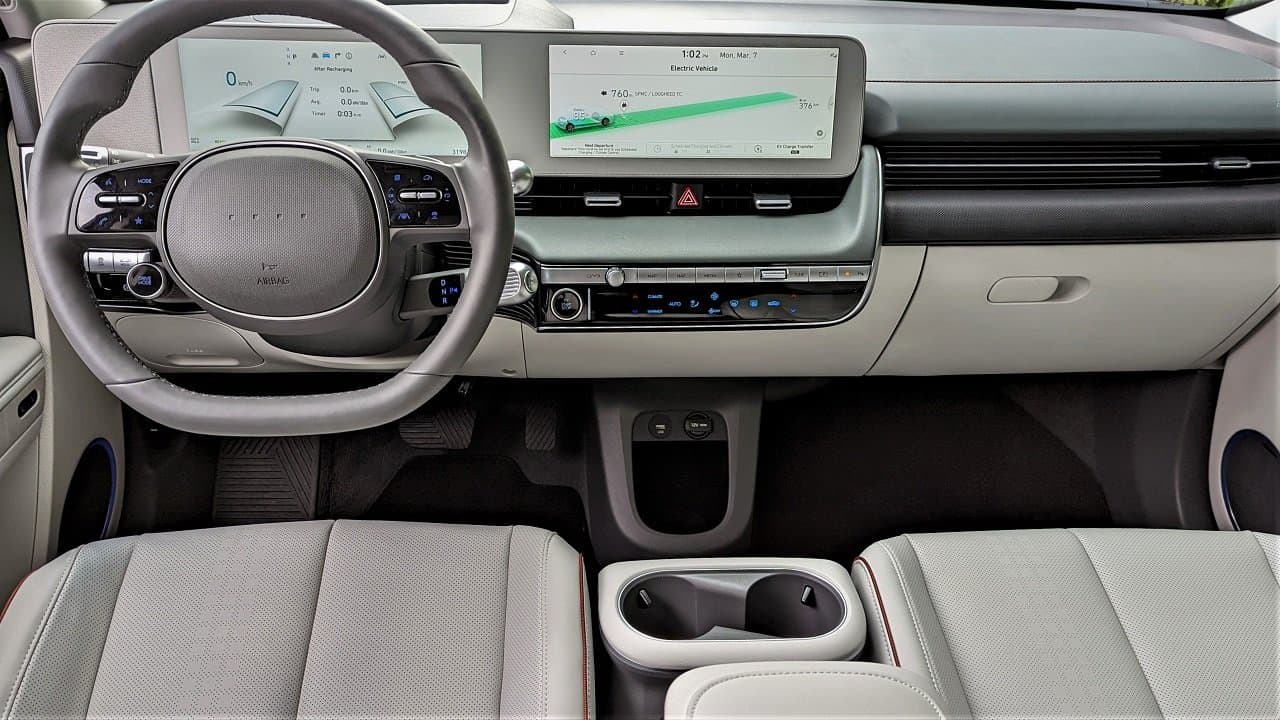
The Ioniq 5 has quite a few little storage areas to put away a lot of your gadgets, water bottles, purses, and other small things you’ll bring with you. The Ultimate package comes with a sliding center console that can move 140 millimeters (5.5 inches). The center console features two cup holders, an armrest that also small enclosed storage area, and a large opening below for purses, etc. The fully loaded Ioniq 5 also has a wireless phone charger in the center console.
The steering wheel’s spokes come with piano black sections with writing on them; at first glance, they look like touchscreens but they’re actually physical buttons that you press on to perform different commands. These buttons let you scroll between different screens on the digital gauge cluster and for setting up the automatic cruise control. The steering wheel column houses the gear selector; twisting the end of it forward puts the car in D (drive), twisting it backward puts it into R (reverse), and clicking the button at the end of the stalk puts it into P (park).
The interior is extremely quiet, which you’d expect in a car with no internal combustion engine. But in some of the electric cars I’ve driven, because the internal combustion engine is gone, quite a few of the creaks and sounds are not masked by the engine, which makes you more aware of these sounds. However, the Ioniq 5 is luxury-level quiet; at highway speeds, there is a bit of wind noise around the A-pillar, but that’s because of the shape and isn’t really too noticeable if you aren’t looking for it. In city driving, the interior is dead quiet. Hyundai has done a great job with the sound-deadening materials on the Ioniq 5.
The fit and finish are excellent, with no misaligned panels on the inside (or outside). The material is of great quality, with lots of soft-touch materials on the dashboard, doors, and center console. Our review Ioniq 5 came with the “vegan leather” seats in white with red piping, it looked great and the material was super supple. The top-of-the-line Ioniq 5 also comes with a “Relaxation mode” driver’s seat, which lets you recline the seat and brings the built-in ottoman up. The idea behind this is so you can relax while waiting at a charging station to top up the batteries. I would’ve liked the ottoman to come up a bit higher, raising your legs more.
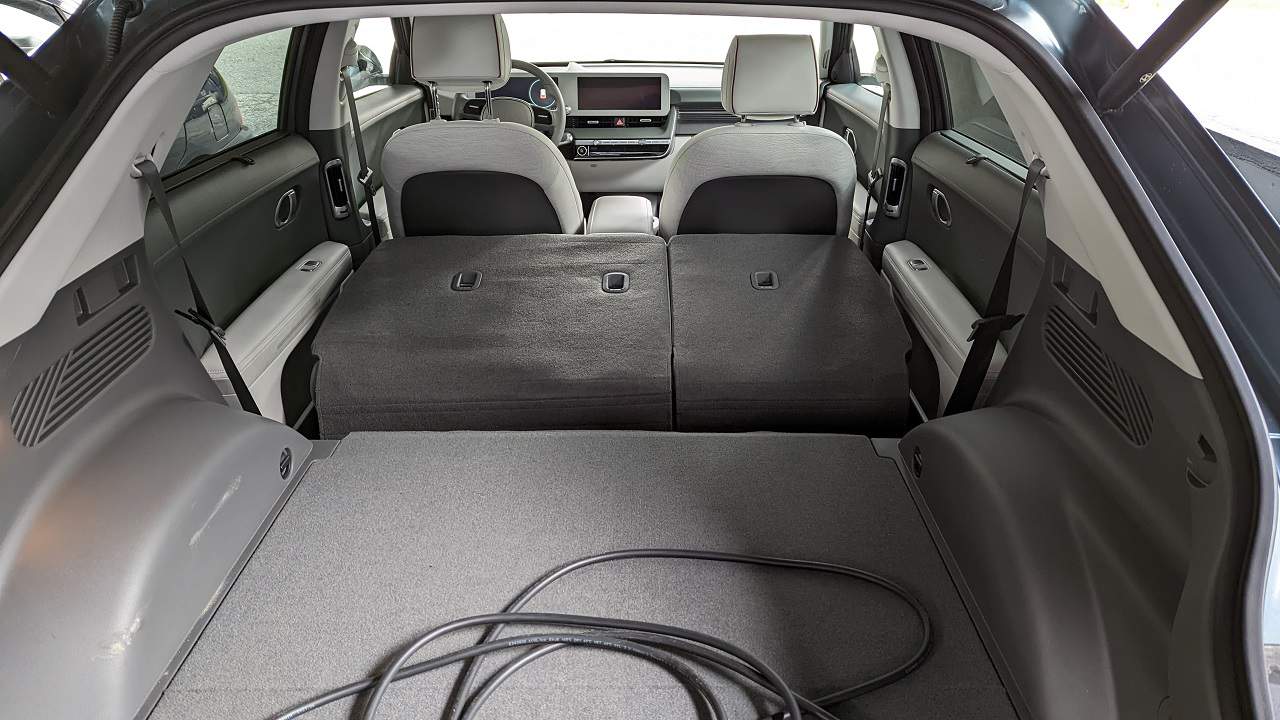
The trunk, or cargo area, isn’t the biggest in its class, coming in at 770 liters of volume with the second-row seats in an upright position. However, the seats can move forward to give some extra cargo area. If you need more room, the second-row seats can be folded, giving you 1,680 liters of volume. The seats can’t be folded from the trunk; you have to go around and individually fold each seat (60/40 split). The Ioniq 5 has a front trunk, but it is quite small, with a volume of 24 liters. In Europe, the “frunk” is bigger on the single-motor Ioniq 5. Still, in North America, all trims get the smaller frunk because of the regulations that require manufacturers to have a trunk (front trunk in this case) release on the inside of the trunk.
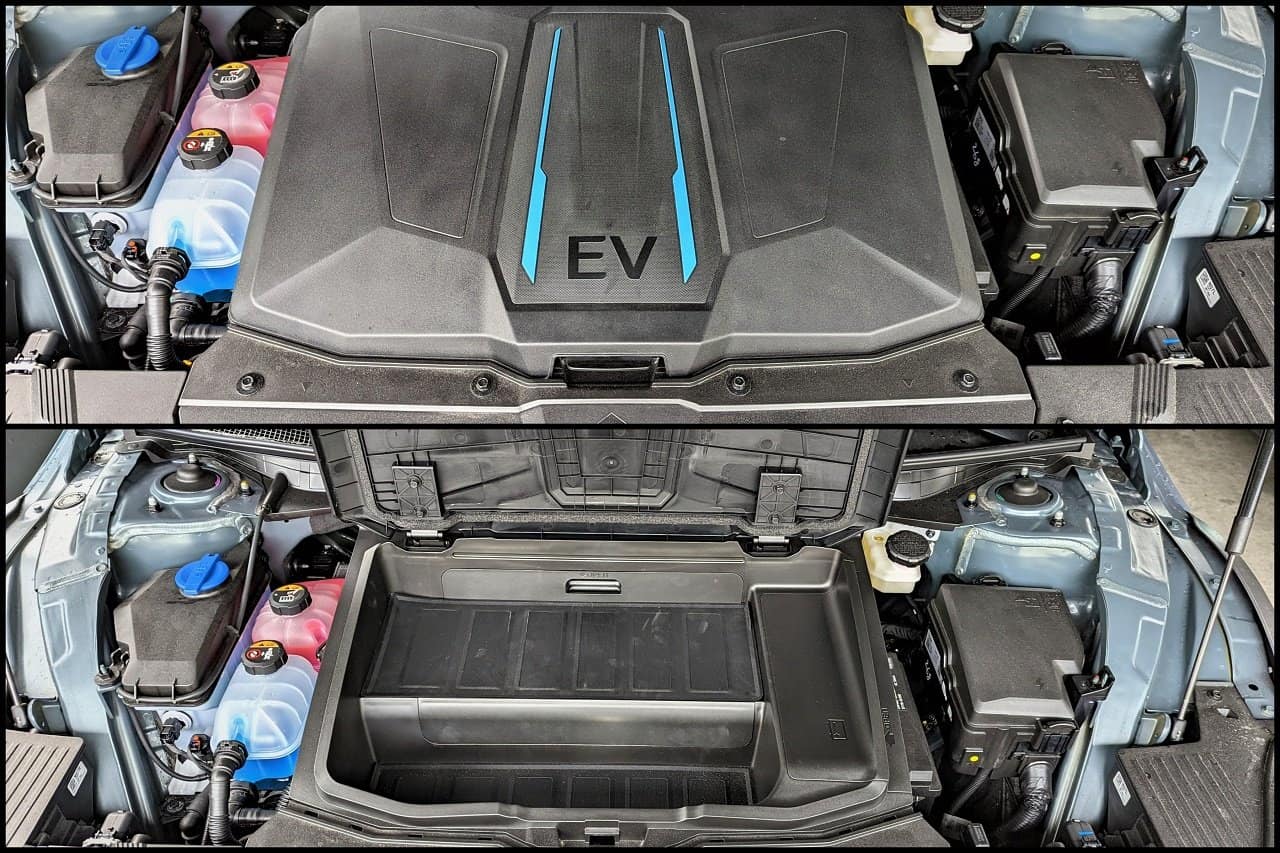
Hyundai is known for providing all sorts of tech gadgetry in their vehicles. The Ioniq 5 is their flagship EV, so they didn’t skimp on any safety, tech, and convenience goodies. Of course, not all the features are available on all trims/packages, but the higher you go up in the price, the more equipment you’ll get. Our review car was the top of the line, so we got all the goodies. Below is a long list of features on the 2022 Ioniq 5 Preferred with Ultimate Package:
- LED Exterior Lights (Front, Rear, DRL, Signals)
- Automatic headlights
- High Beam Assist
- Power-folding Mirrors
- Blind-Spot Collision-Avoidance Assist
- Rain-sensing windshield wipers
- 8-way Power driver’s seat w/ height adj, 2-way power lumbar
- 8-way Power passenger seat w/ power lumbar
- Heated/Ventilated front seats
- Integrated memory system (IMS) for driver seat
- Driver’s Seat w/ “Relaxation” Function
- Android Auto & Apple CarPlay
- Rearview Camera with Dynamic Guide
- Premium Heads-up Display (HUD) with AR Functions
- Wireless Device Charging
- Dual automatic temperature control w/ Driver-Only mode
- Heat Pump & Battery Heating System
- Sunroof – “Vision” Fixed Panoramic Glass w/ sunshade
- Hands-free smart power liftgate with auto open
- Charge-port Door – Power open and close
- Smart Cruise control w/ Stop & Go + Machine Learning (steering wheel-mounted)
- Power windows with front auto-down/up
- Remote keyless entry system with alarm and panic
- Proximity key entry with push-button start
- Remote Smart Parking Assist
- Hood remote release
- Charge Door remote release
- Rear side-window sunshades
- Vehicle to Load (V2L) Two-way on-board charger (2nd row)
- Auto-dimming inside rearview mirror w/ HomeLink
- Proximity Key w/ Push Button Start
- Regenerative Braking System with Anti-lock Braking System (ABS) with 4-wheel disc brakes
- Electronic Stability Control (ESC) with Traction Control (TCS) and Brake Assist
- Vehicle Stability Management
- Tire Pressure Monitoring System (TPMS) with Individual Tire Indicator and Tire Fill Complete Alert
- Parking Distance Warning (Forward/Reverse)
- Parking Collision Avoidance Assist – Reverse
- Forward Collision-Avoidance Assist with Car/Ped/Cyclist Detection and Junction Turning/Crossing
- Lane Keeping Assist (LKA)
- Lane Following Assist (LFA)
- Intelligent Speed Limit Assist
- Driver Attention Warning (DAW)
- Safe Exit Assist (SEA)
- Highway Driving Assist II (HDA II)
- High Beam Assist (HBA)
- Rear Occupant Alert (door logic type)
- Remote smart parking assist (RSPA)
- Surround View Monitor (SVM)
- Blind View Monitor (BVM)
One of the highlights of the Ultimate package is the auto park feature. We saw this feature on the hydrogen-powered Hyundai Nexo. The Ioniq 5 self-parks by backing into a parking spot and parallel parking in and out. These two functions can be activated with you in the car or by standing next to the car while holding the appropriate buttons on the key fob. It is a pretty cool party trick and can come in handy in tight parking spots.
The other highlight is the V2L (vehicle to load), which lets the car power household items using the car’s onboard batteries. There is a regular household outlet at the back of the center console. Alternatively, you can purchase an adapter that sticks into the charging port; it lets you run (or even charge another vehicle) from the outside.
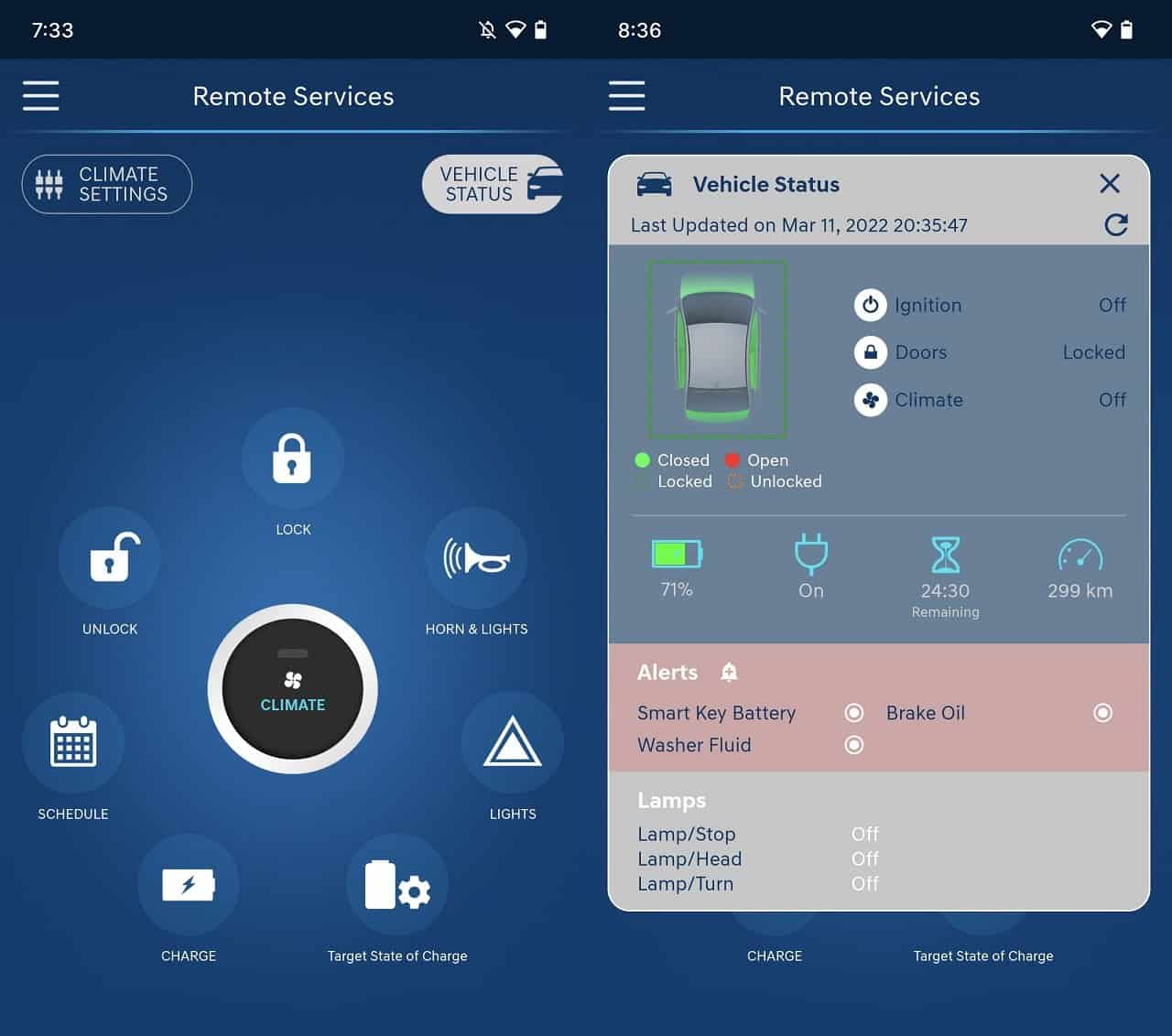
The Ioniq 5 also comes with an app called BlueLink. This app lets you perform various tasks like locking/unlocking the car, scheduling charging times, pre-heating the cabin, scheduling the pre-heating, and checking the general vehicle status. I had no issues with using the app and found it simple to install and use.
Recommendations to Hyundai (or Things I Wish for in the Ioniq 5)
Below are some of the things I would like Hyundai to add.
- USB-C Ports – Although the Ioniq 5 comes with 4 USB-A ports, there are no USB-C ports, which is becoming the standard now.
- Lock/unlock button only on the front doors.
- Auto up/down only on the front two windows.
- A rear wiper
Most of the things on this list are minor, however, the omission of the rear wiper is a major issue in my opinion and I would like Hyundai to remedy that ASAP. A rear camera in the back that displays the image in the rearview mirror might be a quick fix if Hyundai doesn’t want to spend too much time tinkering with the rear spoiler for a wiper. Although the Tucson does have a rear wiper hidden in the rear spoiler.
Hyundai Ioniq 5 EV Warranty
Hyundai provides a good warranty with the Ioniq 5, giving you peace of mind and a great customer experience. A 5-year 100,000-kilometer limited warranty covers the car, and an 8-years 160,000-kilometers battery components warranty.
Final Thoughts
Hyundai is not new to electric vehicles; they’ve been offering the Ioniq EV (which also has a hybrid and plug-in hybrid version) and the Kona EV. However, the Ioniq 5 is their first fully dedicated EV based on the E-GPM platform shared with Kia and Genesis. I think Hyundai has done an incredible job with the Ioniq 5 with its range, power, features, and looks. A few things can be improved, like a rear wiper, but overall, I was extremely impressed with the Ioniq 5 EV.
If you’re in the market for a mid-size CUV, the Ioniq 5 definitely should be at the top of your shopping list. The Ioniq 5’s current direct competitors include the Tesla Model Y (it’s much pricier and doesn’t qualify for the Canadian EV incentives), the Ford Mustang Mach-E, the Volkswagen ID.4, and the Kia EV6. There are other vehicles in the midsize CUV segment scheduled to hit the market soon, but for now, these are the options in this segment.
For more information on the Ioniq 5 and other Hyundai vehicles, head to their official website.
Ordering an Ioniq 5
With all this info at your disposal, you’re about to run to your local Hyundai dealer to buy an Ioniq 5. Not so fast, because of the so-called “chip shortage” and general shortage of batteries, the Ioniq 5 is completely sold out for the 2022 model year. You can, however, put a $500 deposit down at your local dealership, and they’ll add you to the waitlist once Hyundai opens their order books at some point in April or May 2022 for the 2023 model year.
